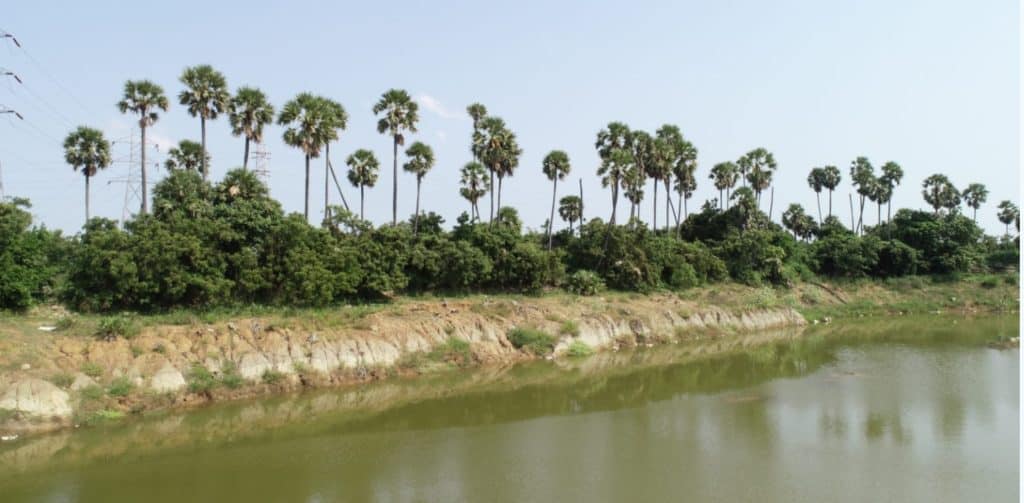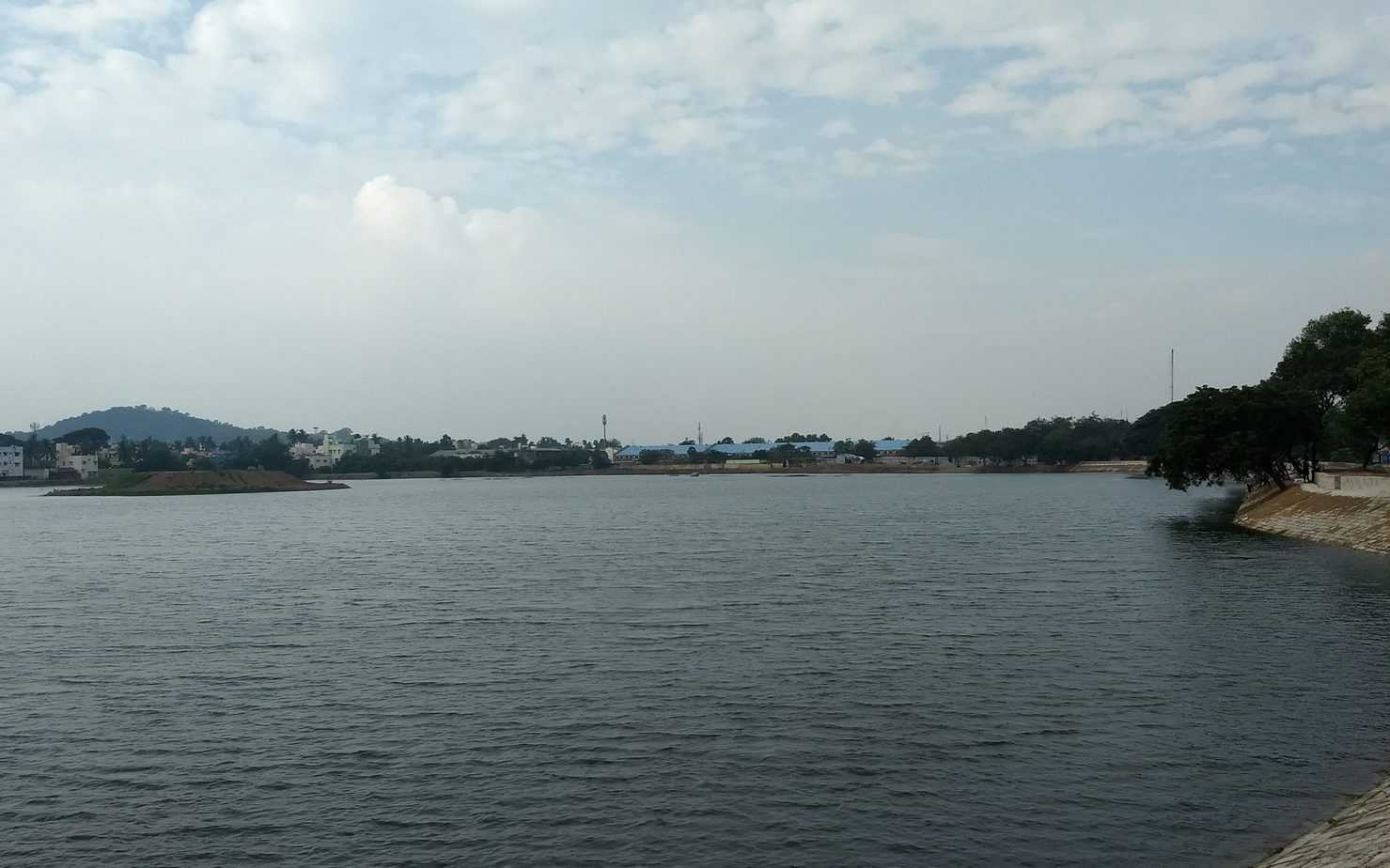Over the past few years, especially after the December 2015 floods, we have seen varying figures on the number of lakes being restored in the Chennai Metropolitan Area. Greater Chennai Corporation, through the Chennai Smart Cities Limited has a goal of restoring 210 lakes, working with NGOs and other civic organisations who are also working on lake restoration independently. Much of these restoration efforts are volunteer-driven and typically involve clean ups, erecting fences and creating spaces for birds. Some restoration efforts also involve removal of encroachments, desilting, and reviving connecting channels.
As of June 2021, around 180 water bodies under the jurisdiction of the Greater Chennai Corporation have undergone restoration, with many more projects in the pipeline. As such, there are no standard guidelines to ensure that a systematic and scientific approach is followed and rarely are the efforts properly planned and monitored to ensure sustainable impact.
Read more: Saving lakes in Chennai: Why maps and physical markers are critical
Given this ground reality, Okapi Research and Advisory (an environmental research and consulting agency), and Care Earth Trust (a Chennai-based NGO) have decided to develop a science-based, easy-to-read ecological lake restoration handbook which is accessible by anyone interested in learning/implementing restoration work. The handbook, which is expected to be launched in the next couple of months, focuses on ecological restoration of static wetlands such as ponds, lakes, kulams and eris. This will not include rivers or streams.
While the broader principles of restoration are applicable to other Indian contexts as well, this handbook has been based on learnings from the Chennai Metropolitan Area. The work has been funded by Azim Premji University.

What does the restoration process entail?
The process of science-based restoration requires good understanding of local hydrology, ecology, governance systems and socio-cultural practices in the area around the water body. The handbook recommends taking an approach to restoration which allows for course correction, takes into account long-term sustainability and involves varied types of stakeholders. These stakeholders can range from government departments, to local communities and other non-governmental organisations as relevant to each case.
The process is comprised of the following steps:
Research and assessment on the past and current state of the lake:
The first step involves conducting thorough research on the history of the lake as well as its current state in terms of hydrological aspects and social use. Historical analysis would include finding out the original extent of the site, its original uses, its erstwhile connections to riverine / non-riverine systems, etc.
For example, Pallikaranai marsh used to span around 6000 hectares**, and before the restoration of the marshland, it had been reduced to only 10% of its original spread. The rest was lost to development. A study on its uses made it clear that the communities surrounding the lake, and the region as a whole, would largely benefit from the restoration process.
The lake, prior to its degradation, worked as an effective natural system for groundwater recharge and as a flood reservoir during heavy rains. Over time, however, it had become a popular dumping ground that saw sewage regularly flow in from Tambaram, Pallavaram and Chitlapakkam. As a result, the patterns of the kind of waste coming in were also studied.
Hydrological aspects to be studied include: mapping the site (to understand maximum surface area, shape and perimeter), catchment run-off, condition of the bunds and surplus weirs, the type of flora and fauna associated with the lake, the capacity of channels, and so on.
Read more: Wetland turns treasure trove of herbs
It is important to complement this research with a good understanding of the current socio-cultural conditions around the lake i.e. any change in built environment, current uses, government and non-governmental groups associated with the lake, water extraction, and pollution details. It is also important to involve the local community in this process to get a sense of their relationship with the lake. This research would provide a strong baseline for the planning and measuring of the actual restoration work.
Setting the restoration goals:
The background research can help set specific goals for the restoration effort and provide direction for the ‘action’. Such goals may include maintaining the current area, groundwater recharge, stopping groundwater depletion, restoring species diversity or a combination of the above.
Current projects often fail to clearly identify goals and therefore fail to identify the relevant activities required to achieve and monitor those goals. For example, if the goal is to increase ground water recharge, some level of desilting is typically required to enable increased groundwater recharge; mere removal of solid waste is not enough.
Carrying out the restoration
Once the goals are set, on-the-ground restoration may begin and it is important to start well before the monsoon season so that work is complete before the lake starts to fill up.
Depending on the goals, on-the-ground activities typically include: desilting and dredging (only for lakes and not marshes) based on a bathymetric assessment of the lake bed, bund stabilization and compaction to ensure it can hold the water. Other important activities include, repairing channels and weirs, cleaning and removing invasive species, creating a space for birds (just small mounds so that excess water is not displaced) where relevant, building recharge wells and undertaking bund planting.
Operationalising an exit strategy:
The last step in the restoration process is perhaps the most critical. There have been several cases where the ‘restored’ lake’s quality has deteriorated soon after the restoration effort. To avoid this, a clear and well-defined post-restoration management strategy has to be put in place before the completion of restoration activities. To be effective, this strategy needs to have clearly defined roles and responsibilities of relevant stakeholders including government and non-government agencies and the community. Many initiatives have seen a great deal of community participation and activism to maintain nearby water bodies, as is the case for both Sembakkam (restoration still ongoing) and Chitlapakkam Lakes.
Read more: Retteri lake: The ‘heart of the community’ that citizens are fighting to save
The strategy must also include thorough documentation of the activities that were carried out, so as to enable effective evaluation in the long run. Quantifiable indicators such as retention capacity or the number of recharge wells, should be monitored for this.

Misconceptions that have emerged
While the above-mentioned steps sound straightforward, there are several misconceptions that need to be addressed. On observing restoration efforts across the region, the presence of large birds such as Spot Billed Pelicans in and around the lake, has emerged as a common indicator for success. This need not be the case, however. Each lake has its own unique fauna and the indicator species must be understood accordingly. For lakes which are not very deep such as Perumbakkam lake, birds such as Pheasant-tailed jacana are a more relevant indicator species than Pelicans, which are more suited to deeper lakes like Sembakkam.
Another misconception related to birds arises when spaces are created for them. Creating islands for birds has become a common feature of lake restoration but traditionally water bodies did not have any such structure inside them – they were free flowing and still attracted birds which perched on the bunds and around the lake. If there is an absolute need to create spaces for birds then it is important small mounds are created and not hillocks, as these may result in more water being displaced than before.
As such, the two critical steps to keep in mind while restoring lakes are: a thorough background research of not just technical aspects but also socio-political and cultural factors, and having a solid exit strategy and long term management plan.
Leveraging effective wetland restoration for a sustainable and resilient future
As the frequency and intensity of extreme weather-related events increase in the Chennai region, it is important to continue to scientifically restore more and more lakes and other water bodies to build resilience and adapt to these extreme events. The IPCC’s AR5 (2014) states that lake maintenance and restoration is an essential and effective ecosystem-based solution for adapting to multiple climate change risks. This is because it performs several functions including protecting downstream areas from flooding, reducing erosive impact of storms by storing run-off, reducing peak flows, maintaining local water climate, and providing ecosystem support.
Actions to protect and restore wetlands are thus critical for countries to achieve their Nationally Determined Contributions (NDCs) under the Paris Agreement and contribute to the Sustainable Development Goals (SDGs). Goal 11 under the SDGs, for example, highlights the urgent need to make cities and human settlements resilient and sustainable. NDCs are the efforts and long term goals, agreed to by various countries as part of the Paris Agreement, for reducing emissions, climate change mitigation, and increasing adaptation to harmful conditions.
Urban areas including cities need to do their bit to contribute towards meeting these targets; Restoring lakes in a methodical, well researched and sustainable way should be a key priority in this process.
**Corrigendum: The figures had been erroneously attributed to Sembakkam Lake in the first published version and has since been corrected. We apologise for the inadvertent error.
Even making worst also u can learn from Chennai. Pallavaram to GST, There are 2 lakes. One is maintained properly. The other one, if someone can take an initiative to clean that, will be good. It’s in worst condition. Digging a new water body is very difficult. But atleast we can keep the existing one safety and clean.
All this sounds great but words and research doesn’t help if it’s not implemented. Korattur lake is one such lake which n eda urgent help. The water levels are rapidly going down and hyacinths are spreading at a fast rate. Twice our CM came to view the lake but after that not a word . Wonder if the lake will disappear altogether before action is taken. 600 acres of lake. What a pity
Must take immediate actions to save Korattur Lake as matters are serious and chemicals can harm human existence..and also flora and fauna equally.